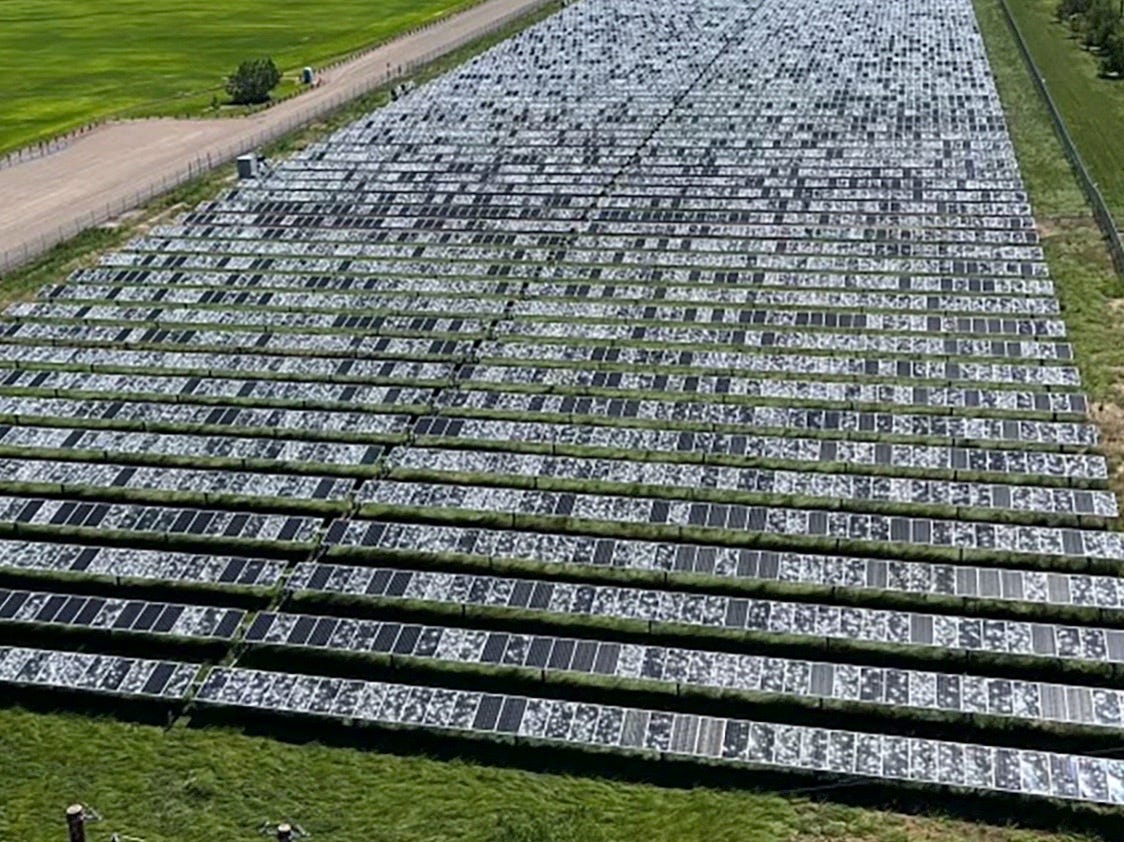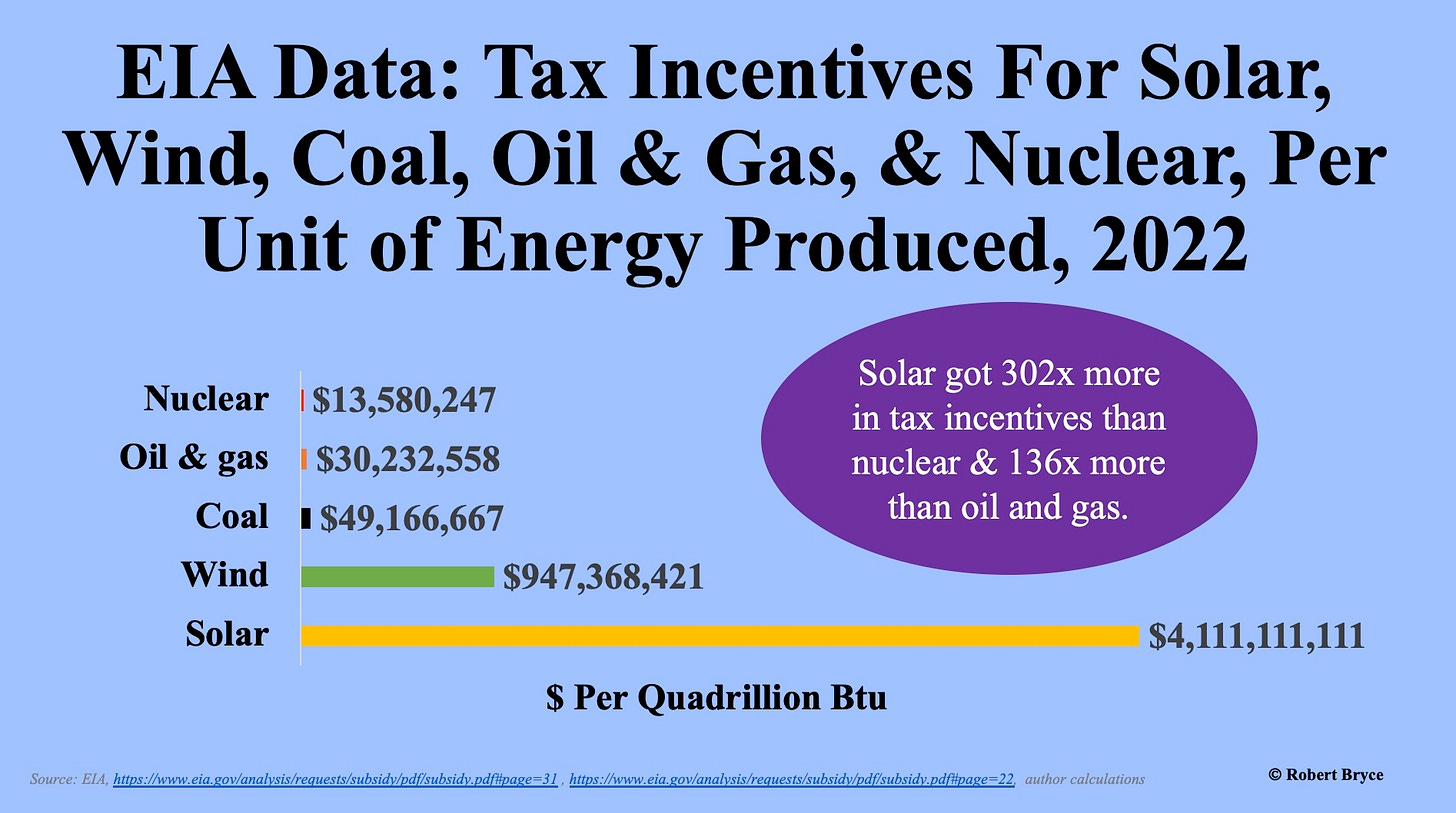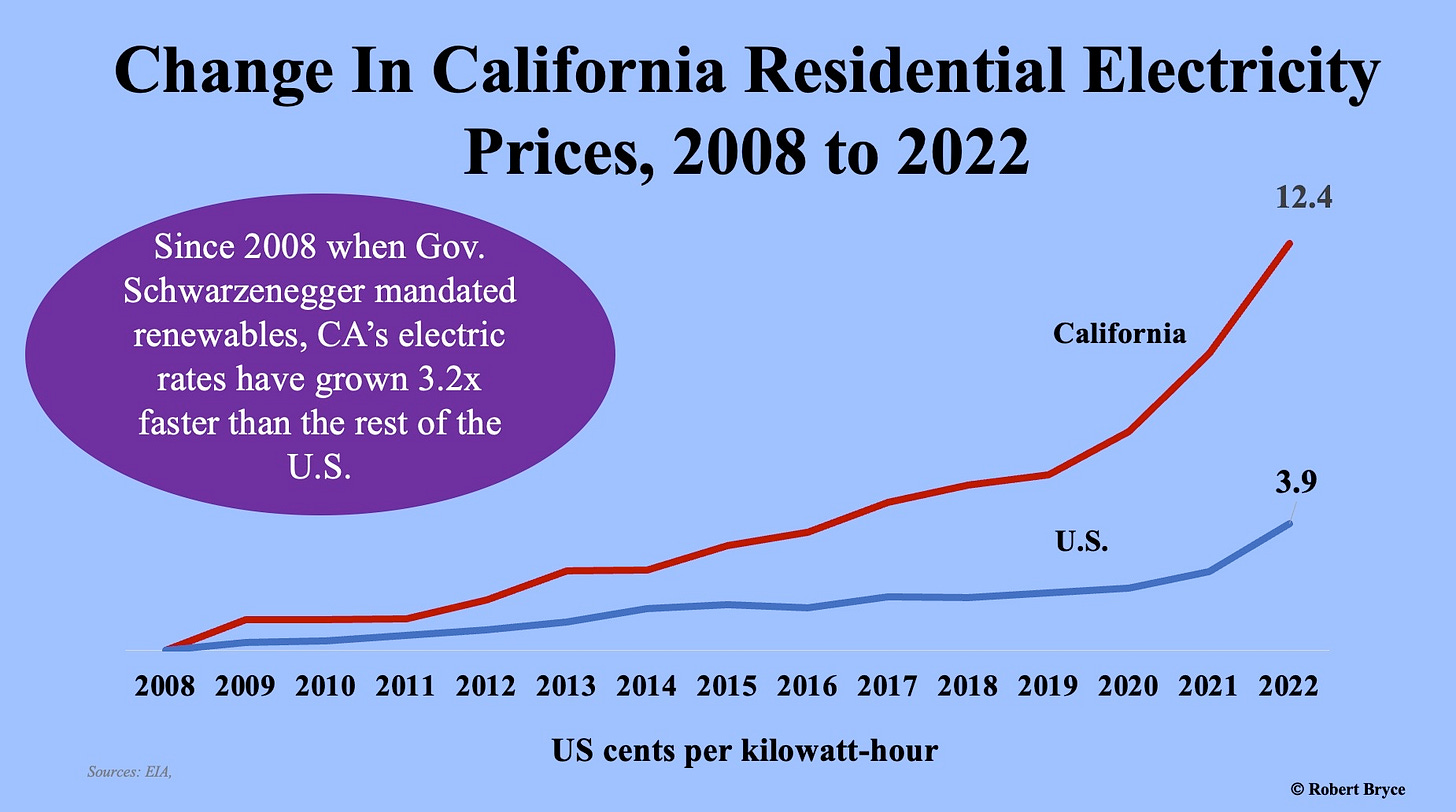Actually, Solar Is Getting 302 Times More In Federal Subsidies Than Nuclear
An August EIA report shows my prior calculations were too low by half

Solar subsidies are even bigger than what I reported here last week. A lot bigger.
On September 22, I published my calculations on solar subsidies. I found that federal incentives for solar energy were 200 times greater than those given to nuclear when calculated on an energy-produced basis. I arrived at that number by combining data from the Joint Committee on Taxation with domestic energy production numbers from the Statistical Review of World Energy.
However, after further review, my calculations were too conservative. They were too low by half. Data published last month by the Energy Information Administration show that subsidies for solar in 2022 were 302 times larger than those given to nuclear.
Before continuing, I must credit my friend, Joseph Toomey, who alerted me to the August EIA report. You “didn't need to run all over town trying to find the energy output data,” he told me via email. Joe was right. The EIA report, “Federal Financial Interventions and Subsidies in Energy in Fiscal Years 2016-2022,” contains numbers for domestic energy production (Table A1) and energy subsidies (Table A5). Joe also pointed me to a good piece he published on LinkedIn last month, in which he made similar calculations to what I posted last week.
The EIA report is vital for several reasons. First, the EIA is a U.S. government agency, so it’s a trustworthy source. Second, the production and subsidy numbers are in a single report, which makes comparisons easy. Third, the report’s format is straightforward. That’s good because one reader complained that he had trouble reading the JCT report. As shown in the screenshots below, the EIA breaks down the subsidies and sums them.
The main difference between the method I used and the EIA report is that the EIA publishes production numbers in Btu instead of exajoules (EJ). That’s not a big deal as one quadrillion Btu is roughly equivalent to one EJ. Further, the denominator doesn’t matter as long as it’s common to all the energy sources. (My friend, Phil Lewis, suggested using gasoline equivalents. We could also use barrels of oil or kilowatt-hours.)
Now back to the numbers. Last year, “total energy subsidies and support” — the phrase used by the EIA in its report — for solar totaled $7.4 billion, and solar production totaled 1.8 quads. That works out to $4.1 billion per quad. Meanwhile, subsidies for nuclear totaled $110 million, and production totaled about 8.1 quads, which means nuclear got $13.6 million per quad. A bit of simple division ($4.1 billion by $13.7 million) shows that solar got 302 times more federal subsidies last year than nuclear.

Subsidies for the landscape-destroying wind energy business totaled nearly $3.6 billion in 2022, while production was 3.8 quads. That means wind energy got subsidies of $947 million per quad, or 69 times more than nuclear.
The enormous subsidies for wind and solar show, once again, that America’s energy policy has been hijacked by climate corporatism, which, as I explained in April, is “the use of government power to increase the profits of big corporations at the expense of consumers — and in particular, at the expense of small (and mostly rural) landowners — in the name of climate change.”
These enormous subsidies reveal the astounding amounts of money that stand to be made by big banks, big business, and big law firms from large-scale renewable development. Recall that earlier this year, the CEO of J.P. Morgan, Jamie Dimon, suggested that governments should consider seizing land by eminent domain because wind and solar projects aren’t being built fast enough. Dimon didn’t mention that his bank is one of the two biggest players in tax equity finance, a $20 billion-per-year industry that’s crucial to wind and solar development. If big wind and solar projects don’t get built. J.P. Morgan will lose out on billions in profits.
These enormous subsidy numbers are also an inconvenient truth for the climate-focused NGOs, activists, and their allies in think tanks and media, who never tire of claiming that weather-dependent renewables are cheaper than hydrocarbons and nuclear.
What about hydrocarbons? The EIA puts total subsidies at about $2.8 billion and production at 80.8 quads. Therefore, the hydrocarbon sector got about $33.4 million in subsidies per quad, meaning solar got 136 times more in subsidies than oil and gas.
According to the EIA, all federal energy-related subsidies totaled $29.4 billion in 2022. Of that sum, about $11 billion went to wind and solar. That’s wildly disproportionate to domestic energy production, which totaled 102.2 quads. Recall that wind and solar together produced about 5.6 quads of energy or 5.5% of domestic energy production, but those two forms of energy production got 37.4% of all federal subsidies. Meanwhile, hydrocarbons got $2.7 billion in subsidies even though they accounted for 79% of domestic energy output. Thus, it doesn’t take a degree for Wharton to see that wind and solar are getting vastly more in federal tax incentives than hydrocarbons in both absolute terms and relative terms.
But remember, the massive federal subsidies for wind and solar represent only a portion of the final cost to taxpayers and ratepayers. That can be seen by looking at California, which has pushed wind and solar harder than any other state. Last year, California generated more electricity from solar (about 60 terawatt-hours) than any other state. That was more than twice as much as second-place Texas, which produced about 25 terawatt-hours of juice from solar.
The result of California’s solar dalliance? Staggering increases in prices. Since 2008, when Governor Arnold Schwarzenegger signed an executive order requiring the state’s utilities to obtain a third of the electricity they sell from renewables by 2020, residential electricity rates in California have increased three times faster than the rest of the U.S. California now has some of the most expensive electricity in the country. Through the first six months of 2023, residential electricity prices in the state averaged 28.4 cents per kilowatt-hour. That’s the highest price in the continental U.S. outside New England and Hawaii. And remember, those electricity price increases are happening in California, a state with the ignominious distinction of having the highest poverty rate in the country.
Further, as I explained in March in “California Screamin,” electricity costs will continue rising as the Golden State tries to build more wind, solar, and transmission to accommodate weather-dependent renewables. I wrote:
Last year, the California Public Utilities Commission unanimously approved a scheme that aims to add more than 25 gigawatts of renewables and 15 gigawatts of batteries to the state's electric grid by 2032 at an estimated cost of $49.3 billion. In addition, the California Independent System Operator released a draft plan to upgrade the state's transmission grid at a cost of some $30.5 billion. The combined cost of those two schemes is about $80 billion. Dividing that sum among 39 million residents works out to about $2,050 for every Californian. But the final price will undoubtedly be far more than $80 billion.
In that same article, I cited a 2019 study by two academics at the University of Chicago, Michael Greenstone and Ishan Nath, which concluded that wind and solar mandates “raise electricity prices more than previously thought.” The two found that “the intermittent nature of renewables means that backup capacity must be added” and that “by mandating an increase in renewable power, baseload generation is prematurely displaced, and some of the cost is passed to consumers.” They concluded that renewable energy mandates lead to “substantial increases in electricity prices that mirror the program’s increasing stringency over time.”
In addition to the financial cost that solar subsidies will impose on taxpayers and ratepayers, all that federal cash will help create a tidal wave of solar trash that will begin washing into landfills across the country in a few years. A 2021 report published in the Harvard Business Review found that the solar sector is “woefully unprepared for the deluge of waste that is likely to come. The financial incentive to invest in recycling has never been very strong in solar. While panels contain small amounts of valuable materials such as silver, they are mostly made of glass, an extremely low-value material.” The article continued:
We see the volume of waste surpassing that of new installations by the year 2031. By 2035, discarded panels would outweigh new units sold by 2.56 times. In turn, this would catapult the LCOE (levelized cost of energy, a measure of the overall cost of an energy-producing asset over its lifetime) to four times the current projection. The economics of solar — so bright-seeming from the vantage point of 2021 — would darken quickly as the industry sinks under the weight of its own trash.
Last year, the Los Angeles Times reported that solar panels can contain toxic components like lead, selenium, and cadmium. But California won’t be recycling many of the old solar panels because the state’s “rigorous permitting system for toxic materials makes it exceedingly difficult to set up shop.” The article also cited the National Renewable Energy Laboratory, which has “estimated that it costs roughly $20 to $30 to recycle a panel versus $1 to $2 to send it to a landfill.”
Unfortunately, the $7.4 billion in federal subsidies given to solar last year may be only a foretaste of the climate corporatism to come. As I reported last Friday, under the Inflation Reduction Act, annual federal giveaways to solar could triple to $22 billion by 2036 and total as much as $50 billion by the late 2040s. Those massive subsidies for solar energy, which we are continually told is “green,” “clean,” and “renewable,” will create a staggering volume of solid waste that will largely go into landfills because it costs too much to recycle them.
Last year, energy analyst Brian Gitt, who has a significant following on X, published a thread on the site that got more than 3 million views. The thread began, “I used to think solar was the best way to make electricity, but I was wrong.”
Policymakers should come to the same conclusion, and they should do so right darn quick.
Please click that ♡ button. And don’t forget to subscribe and share.
Remember to check out the Power Hungry Podcast.
Thanks.






Great article.Once again you are spot on.Thank you for this.I am going to use this for our next meeting with the board of the county here that we are trying to stop from letting more solar installations be built.The general public simply does not understand any of this.We will continue to educate the public and the county officials.We will never give up nor never give in.
$olar energy = gov’t grift